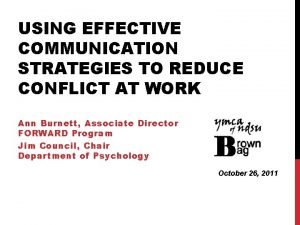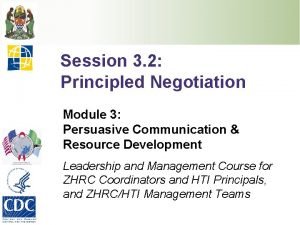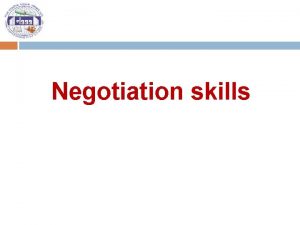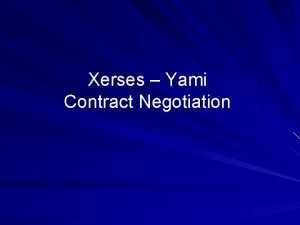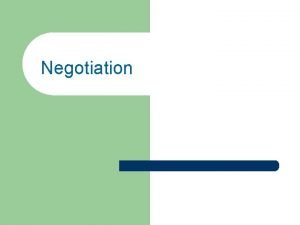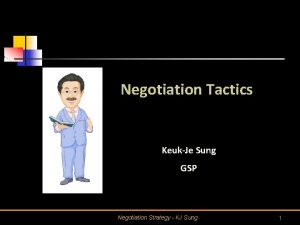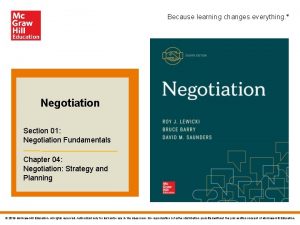Negotiation Techniques A Guide to Getting What You





















- Slides: 21

Negotiation Techniques: A Guide to Getting What You Want

What is Negotiation? Negotiation is a dialogue intended to resolve disputes, to produce an agreement upon courses of action, to bargain for individual or collective advantage, or to craft outcomes to satisfy various interests. Module 2 1

Approaches to Negotiation • Advocate Approach: A skilled negotiator works on behalf of one party to get the best possible deal for his/her party. • Win-Win: Finding a way for each party in the negotiation to get what they want…or at least get something. (Roger Fisher and William Ury, Getting to YES) • Creative Approach: Developing new ways for each party to enjoy maximum benefits through cooperation. REMEMBER: As a negotiator, it is not necessarily your job to get to win-win…it is your job to win…to get what is best for your stakeholders. If the other side wins too that is fine, but it is not your goal in the negotiation. Module 2 2

10 Questions to Ask Before Negotiating • • • How do you need to prepare (homework)? What are the economic ramifications? What are the technical ramifications? What are the social ramifications? What is your leverage in the negotiation? How can you use this leverage? What other factors should you consider? How does the deal increase prosperity? How can transparency be assured? How can you monitor implementation if there is an agreement?

Ten Rules for Global Negotiation (Hernandez and Graham) 1. 2. 3. 4. 5. 6. 7. Accept only creative outcomes Understand cultures, especially your own Don’t just adjust to cultural differences, exploit them Gather intelligence and reconnoiter the terrain Design the information flow and process of meetings Invest in personal relationships Persuade with questions. Seek information and understanding 8. Make no concessions until the end 9. Use techniques of creativity 10. Continue creativity after negotiations 3

Ways to Generate More Ideas • • Establish common goals for collaboration. Establish the rules of engagement. Establish trust between the negotiating parties. Add diversity to the group. Use storytelling. Work in small groups. Sleep on it. 4

Negotiation Styles • • Accommodating Avoiding Collaborating Competing Compromising Conflict-Oriented “Good Cop, Bad Cop” 5

Emotion in Negotiation • This can have a positive or negative affect depending on the mindset of the negotiator. • Emotion can create irrational responses or facilitate an agreement, depending on how it is used. Module 2 6

Culture and its Effect on Negotiation • • • Module 2 Language Customs Religion Hierarchy Age Gender 7

Negotiation in Japan Consistent with most descriptions of Japanese negotiation behavior, the results of this analysis suggest their style of interaction is among the least aggressive (or most polite). Threats, commands, and warnings appear to be de-emphasized in favor of the more positive promises, recommendations, and commitments. Particularly indicative of their polite conversational style was their infrequent use of no and you and facial gazing, as well as more frequent silent periods. Module 2 8

Negotiation in Russia The Russians’ style was quite different from that of any other European group, and, indeed, was quite similar in many respects to the style of the Japanese. They used no and you infrequently and used the most silent periods of any group. Only the Japanese did less facial gazing, and only the Chinese asked a greater percentage of questions. Module 2 9

Negotiation in Spain Diga is perhaps a good metaphor for the Spanish approach to negotiations evinced in our data. When you make a phone call in Madrid, the usual greeting on the other end is not hola (“hello”) but is, instead, diga (“speak”). It is not surprising, then, that the Spaniards in the videotaped negotiations likewise used the highest percentage of commands (17 percent) of any of the groups and gave comparatively little information (selfdisclosures, only 34 percent). Moreover, they interrupted one another more frequently than any other group, and they used the terms no and you very frequently. Module 2 10

When Negotiating, Remember…. Remember • • You are acting on behalf of your client not yourself. You are there to get what is best for your client. Being liked is nice, winning is better. Never burn a bridge you are standing on at the time. Playing “hardball” can be an all or nothing strategy. The truth lies somewhere in the middle. Don’t make it personal and don’t take it personally. Emotion can undermine your negotiation strategy. Module 2 11

“The baseline is that everybody lies. ” Gregory House, M. D. Module 2 12

Detecting Lies in Negotiation: Verbal Cues • • Uses your words Won’t stop talking Aggressively stonewall Won’t answer direct questions Reactions are disproportionate Answers your questions but asks none Not indignant or excessively indignant when accused Answers a question with a question Module 2 13

Detecting Lies in Negotiation: Visible Cues • • • Module 2 Develops a nervous tick Sips water incessantly Begins blinking excessively Won’t make eye contact Begins sweating 14

Techniques in Conflict Negotiation • • • Module 2 Avoidance Projection Reaction Formation Displacement Counterphobic Rationalization 15

Four Reasons Why People Become Irrational • • To Reflect Blame Habitual Reaction To Provide a Measure of Excitement To Gain Approval from Others Module 2 16

Measures to Overcome Conflict in Negotiation • • • Remain calm. Continue to bring the discussion back to the salient issues. Keep “feeding the rope”. Maintain a friendly demeanor. “Plaster on that smile”. Take a break. Try to better understand the other party in the negotiation. Module 2 17

Questions Module 2 18

The YALI Regional Leadership Center East Africa is also supported by:
 The secret to getting ahead is getting started
The secret to getting ahead is getting started Getting nerdy llc genetics answer key
Getting nerdy llc genetics answer key How are you
How are you Wind knocked out
Wind knocked out Fonction technique scooter
Fonction technique scooter Do you love rain
Do you love rain Good health is a choice agree or disagree
Good health is a choice agree or disagree If you think you can you can poem
If you think you can you can poem Tell me what you eat and i shall tell you what you are
Tell me what you eat and i shall tell you what you are I will follow wherever you may go
I will follow wherever you may go Expanding the pie in negotiation
Expanding the pie in negotiation Negotiation anchoring
Negotiation anchoring Interest-based negotiation
Interest-based negotiation Three schools of bargaining ethics
Three schools of bargaining ethics Negotiation
Negotiation Distributive vs integrative negotiation
Distributive vs integrative negotiation Principled negotiation
Principled negotiation Microsoft negotiation strategy
Microsoft negotiation strategy Loci of conflict
Loci of conflict Zopa negotiation
Zopa negotiation Benefits of negotiation
Benefits of negotiation Yale university negotiation course
Yale university negotiation course












